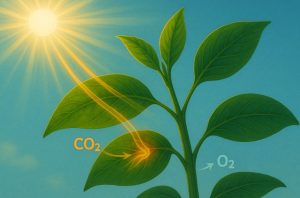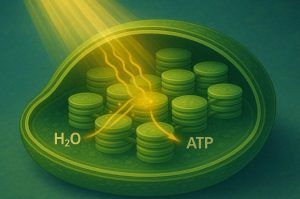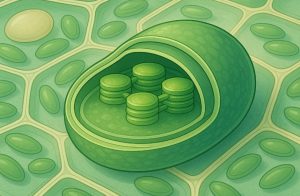Photosynthesis is one of the most essential biological processes on Earth. It sustains plant life and, by extension, supports all other life forms. Through this process, plants convert sunlight into usable chemical energy, producing oxygen as a by-product. The driving question is, why is light needed for photosynthesis?
To understand this, we must explore the mechanisms behind photosynthesis and the indispensable role that light plays in enabling plants to synthesise their own food.
What Role Does Light Play in the Process of Photosynthesis?

Photosynthesis is a process where green plants, some bacteria, and algae convert light energy into chemical energy in the form of glucose.
This occurs primarily in the chloroplasts found in plant leaves. The process is typically represented by the following chemical equation:
6CO₂ + 6H₂O + light energy → C₆H₁₂O₆ + 6O₂
In this reaction:
- Carbon dioxide is absorbed from the air through tiny pores in leaves called stomata.
- Water is absorbed from the soil via the roots.
- Sunlight is captured by chlorophyll, the green pigment in chloroplasts.
The light energy absorbed is used to split water molecules and combine carbon dioxide and hydrogen to form glucose.
This glucose serves as the plant’s food source, powering all its internal functions, growth, and development. Oxygen is released into the atmosphere as a valuable by-product.
Thus, light is not just part of the equation it is the initial catalyst without which the entire process would not proceed.
How Do Plants Convert Light Energy into Chemical Energy?
The transformation of light energy into chemical energy takes place through two interconnected phases:
1. Light Absorption by Chlorophyll
Chlorophyll is the pigment primarily responsible for absorbing light. It is located in the thylakoid membranes of the chloroplasts.
Chlorophyll absorbs energy most efficiently from the blue and red portions of the visible light spectrum. The green portion is reflected, which is why plants appear green.
2. Energy Conversion
Once the chlorophyll absorbs light, this energy excites electrons within the molecule, initiating a chain of reactions that convert water and carbon dioxide into glucose. The energy captured is temporarily stored in two key molecules:
- ATP (Adenosine Triphosphate) – a short-term energy carrier
- NADPH (Nicotinamide Adenine Dinucleotide Phosphate) – a high-energy electron carrier
Both ATP and NADPH are essential to powering the next phase of photosynthesis: the Calvin Cycle.
This process ensures that light energy is not wasted, but rather harnessed efficiently to fuel life.
What Happens During the Light-Dependent Reactions in Photosynthesis?

Photosynthesis is split into two main stages:
- The light-dependent reactions
- The light-independent reactions (also known as the Calvin Cycle)
The light-dependent reactions occur in the thylakoid membranes and can only happen in the presence of light. Here’s a step-by-step breakdown:
- Photon Absorption: Chlorophyll absorbs sunlight and becomes energised.
- Water Splitting (Photolysis): The absorbed energy is used to split water molecules (H₂O) into hydrogen ions (H⁺), electrons (e⁻), and oxygen (O₂).
- Oxygen Release: The oxygen is released into the atmosphere, a crucial process for life on Earth.
- Formation of ATP and NADPH: The electrons and hydrogen ions are used to convert ADP and NADP⁺ into ATP and NADPH.
These two molecules (ATP and NADPH) are then used in the light-independent reactions to produce glucose.
Without the light-dependent reactions, these energy-rich molecules wouldn’t be created, and the entire process of photosynthesis would be stalled.
How Does the Visible Light Spectrum Affect Photosynthesis?
Sunlight is composed of various wavelengths, each corresponding to a different colour. However, plants do not use all wavelengths equally. The absorption spectrum of chlorophyll reveals which colours are most useful.
| Light Colour | Wavelength Range (nm) | Absorption by Chlorophyll | Effectiveness in Photosynthesis |
| Blue | 430–500 | High | Very Effective |
| Red | 600–700 | High | Very Effective |
| Green | 500–570 | Low | Least Effective |
Blue and red light are most effective because they are absorbed efficiently by chlorophyll a and b. Green light is least effective because it is mostly reflected.
This is why the choice of light spectrum is crucial in controlled growing environments like greenhouses and indoor farms.
What Happens to Photosynthesis When Plants Receive Insufficient Light?
Light deficiency affects the rate and efficiency of photosynthesis. Since light provides the energy required to split water molecules and energise electrons, any lack of light causes a significant drop in glucose production.
Effects of Low Light on Plant Function:
- Reduced Photosynthetic Rate: Less ATP and NADPH are produced, limiting glucose synthesis.
- Stunted Growth: With less food (glucose) available, growth slows or stops altogether.
- Yellowing or Dropping Leaves: Plants may reallocate resources, shedding leaves to conserve energy.
- Weaker Immune Function: The plant becomes more susceptible to diseases and pests.
These symptoms are commonly observed in indoor plants that don’t receive enough natural sunlight, highlighting the need for either relocation or the use of artificial light.
What Are the Functions of Chloroplasts and Chlorophyll in Light Absorption?
Chloroplasts

Chloroplasts are double-membraned organelles found in plant cells, particularly abundant in leaf tissue.
Inside them are stacks of thylakoids, where chlorophyll is embedded. These thylakoids form a system that maximises the surface area available for light absorption.
Chloroplasts are essentially biochemical factories that house all components needed for photosynthesis, including enzymes, pigment molecules, and reaction centres.
Chlorophyll

There are different types of chlorophyll, with chlorophyll a being the most important. This molecule is directly involved in the light reactions.
It absorbs light primarily in the red and blue regions, initiating the conversion of light energy into usable chemical energy.
The cooperative action between chloroplasts and chlorophyll ensures that sunlight is absorbed efficiently and directed towards powering plant metabolism.
How Does Photosynthesis Vary Under Different Light Conditions?
Not all light is created equal, and the conditions under which plants photosynthesise can vary drastically. Factors include light intensity, duration, and quality (wavelengths).
Natural Light
Natural sunlight provides a full spectrum of wavelengths and is generally ideal for plant growth.
However, variations due to time of day, weather, and season can affect light availability. In winter months, photosynthetic activity often slows due to shorter daylight hours.
Artificial Light
Grow lights are used in controlled environments to supplement or replace natural light. These lights are often LED-based and can be tailored to emit specific wavelengths that are optimal for plant growth.
| Light Source | Wavelength Control | Suitability |
| Fluorescent Lights | Moderate | Good for seedlings and herbs |
| LED Grow Lights | High | Excellent for full growth |
| Incandescent Bulbs | Poor | Not ideal |
Low-Light Adaptations
Certain plant species have evolved to tolerate low-light environments, such as those found on forest floors or indoors. These plants typically have:
- Higher chlorophyll concentration
- Thinner, broader leaves
- Slower growth rates
Such adaptations enable them to maximise the limited light available.
Summary Table – Why Is Light Essential for the Photosynthesis Process?
| Component | Primary Function | Effect of No Light |
| Chlorophyll | Absorbs light to initiate photosynthesis | Inactive; cannot absorb energy |
| Light-dependent reactions | Create ATP and NADPH from light energy | Glucose production halts |
| Water (H₂O) | Split into oxygen and hydrogen | Photolysis does not occur |
| Oxygen (O₂) | By-product of light reactions | Oxygen not released into atmosphere |
| Glucose (C₆H₁₂O₆) | Plant food and energy source | Plant starves; growth and survival hindered |
Why Is Light So Crucial for Plant Life and Ecosystems?

Light is the fundamental energy source that fuels not only plant growth but the entire food chain. Without photosynthesis, plants cannot produce food, oxygen levels would drop, and life as we know it would not exist.
Beyond just sustaining individual plants, photosynthesis:
- Regulates global carbon dioxide levels
- Maintains the Earth’s oxygen supply
- Supports herbivores, which in turn feed carnivores
- Balances climate systems by storing solar energy
In a broader ecological context, light is the starting point for all biological energy flows on our planet.
Frequently Asked Questions
Can photosynthesis happen without light?
No. The light-dependent reactions require sunlight to begin the process. Without light, photosynthesis cannot occur.
Which colour of light is most effective for photosynthesis?
Blue and red light are most effective due to their optimal absorption by chlorophyll, leading to higher rates of photosynthesis.
How does light intensity affect photosynthesis rate?
Higher light intensity generally increases the photosynthetic rate until the plant reaches a saturation point. Beyond that, excess light can damage plant cells.
Do all plants need the same amount of light?
No. Light requirements vary among species. Some plants thrive in full sun, while others are adapted to shade or low-light conditions.
What role does chlorophyll play in using light?
Chlorophyll captures specific wavelengths of light and uses that energy to initiate the photosynthesis process.
Is artificial light enough for indoor plants?
Yes, provided the artificial light includes the appropriate spectrum and intensity. LED grow lights are particularly effective.
Why does photosynthesis slow down at night?
Photosynthesis relies on light-dependent reactions. In the absence of light, these reactions pause, halting glucose production until light returns.






